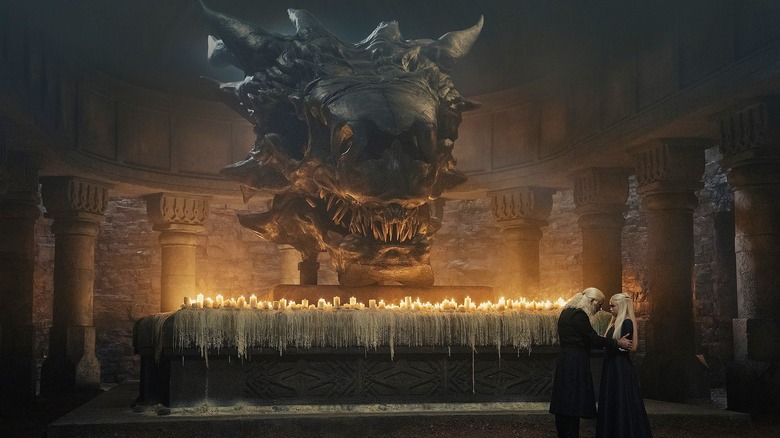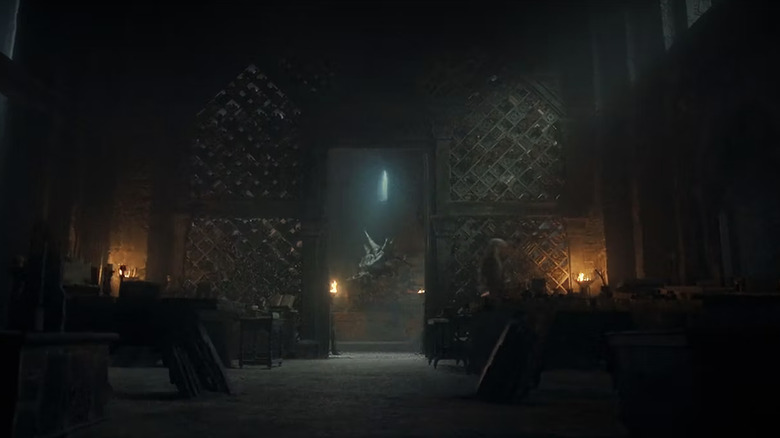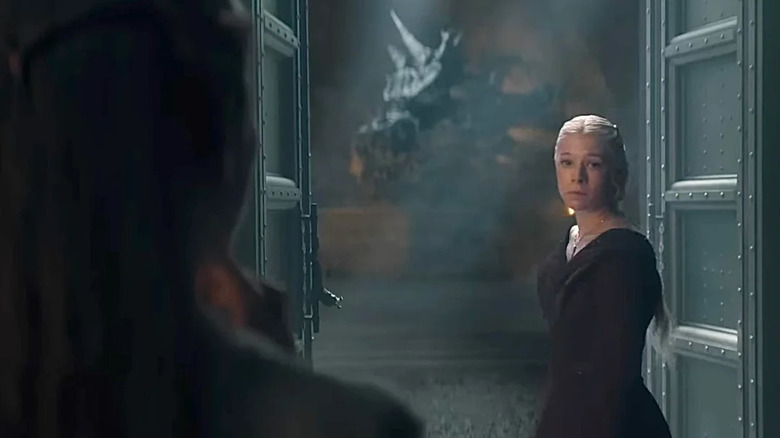One Dragonstone Prop In House Of The Dragon Season 2 Demands A Closer Look
George R.R. Martin's "Game of Thrones" book series and subsequent television series adaptations have a fascinating relationship with dragons. There are plenty of exciting, fantastical, and beloved films about dragons, but few have packed as much lore and symbolism into their dragons as the ones on "GoT" and "House of the Dragon." These flying creatures are capable of devastating power, allowing dragonriders the ability to destroy entire cities and armies without struggle. Those who were able to tame dragons — namely, the Targarayens — were able to forge a dynasty of power and rule. Dragons are essentially nuclear weapons in the Seven Kingdoms, which means no other royal family stands a chance against those who are armed with these awesome beasts. At least, that's how they are in "House of the Dragon."
Over a century later, in "Game of Thrones," dragons are viewed as symbols of liberation. When Daenerys Targaryen mothered three dragons, the first in over 100 years, they became beacons of hope for the oppressed. That yes, even a banished princess sold into chains could pursue freedom and regain power. When dragons die, their bones are often put on display to honor their sacrifice, as well as to remind people of their large stature and great vigor.
In season 2 of "House of the Dragon," Queen Rhaenyra Targaryen speaks with her son, Prince Jacaerys Velaryon, about Aegon the Conqueror's dream — named the Song of Ice and Fire. Behind her is a gigantic skull of a dragon that eagle-eyed fans correctly flagged as Meraxes, the dragon of Queen Rhaenys Targaryen, confirmed by the Westerosies news source.
Queen Rhaenys and Meraxes
Queen Rhaenys Targaryen was the youngest sister of King Aegon I Targaryen, aka, Aegon the Conquerer. Aegon was married to both of his sisters at some point, also marrying Rhaenys' older sister Visenya, but it was rumored that Rhaenys was his favorite. The two brought Aenys I into the world, continuing the line of dragonkings. Of the 16 Targaryen kings that existed, 15 were direct descendants of the two. Aegon was the first Lord of the Seven Kingdoms and the king of the Iron Throne, conquering six of the Seven Kingdoms during the great Conquest and sparking the Targaryen dynasty that led to the Dance of the Dragons between Queen Rhaenyra and King Aegon II Targaryen.
Queen Rhaenys rode Meraxes, one of the three dragons of House Targaryen during their conquest of Westeros. Unfortunately, Meraxes and the Queen were both killed during the invasion of Dorne after Meraxes was struck by a scorpion bolt (a gigantic mounted crossbow), which went through one of Meraxes' eyes. Aegon was so angry and filled with so much grief that he and Visenya burned down all of the Dornish castles for two years, aka the Dragon's Wroth. After the war between House Targaryen and Dorne ended, the Dornish people offered Meraxes' skull as a peace offering. Meraxes joined the 18 other dragon skulls in the Red Keep's throne room until they were moved to a cellar by King Robert Baratheon (as in, the King at the start of "Game of Thrones").
How did Meraxes end up in Dragonstone?
While "House of the Dragon" doesn't explain how Meraxes' skull ended up in Dragonstone instead of its documented place at King's Landing, it's assumed that it was likely moved in a similar manner to Balerion the Black Dread's skull, which was on display in season 1. Westerosies confirmed the identity of the dragon skull with episode 7 director Loni Peristere, putting an end to months-long fan speculation. Meraxes is undoubtedly one of the favorites of both the characters of George R.R. Martin's world and the "Game of Thrones" fandom, considering the frequent homages paid to the glorious flying reptile.
In "Game of Thrones," Daenerys Targaryen renames one of the Illyrio Mopatis ships after her, and Queen Rhaenys' sigil becomes that of Meraxes with the bolt through her eye. In real life, Meraxes was honored by paleontologists in 2012 with the discovery of a large predatory theropod from the Late Cretaceous period. The dinosaur was discovered in Patagonia, Argentina, and properly named "Meraxes gigas." The Meraxes genus currently boasts just the one dinosaur, and was believed to be 39-54 years old when it died.
All hail Meraxes, and long live the queen.


